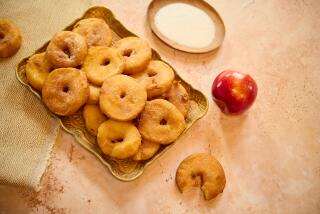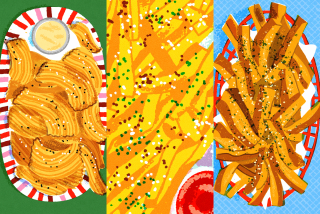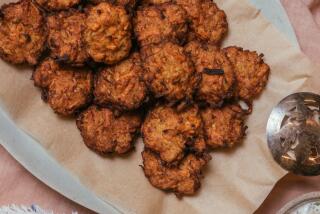Batter Up: It’s the Only Way to Fry
- Share via
Frying is one of the most violent means of cooking possible, and anyone who would deep-fry something without providing it at least a thin blanket of protective batter is nothing short of a barbarian.
Without a batter, food fries to a frazzle: crisp, yes, but shrunken and shriveled as well. Only the tough survive, so it should be no surprise that the foods that last are usually tough, or at least stringy.
But with a batter, you get the best of both worlds. The coating fries crisp and golden; the inside steams, moist, delicate and tender.
But which batter to use? The cook faces a bewildering array of possibilities: a simple dusting of starch; a coating of starch and liquid; a batter of starch, liquid and protein. They all have their benefits, depending on what you want the final dish to taste like.
Michael Blumenthal--food scientist and home cook--says it all depends on how crisp you want your food to be.
Starch by itself--usually either flour, cornstarch or bread crumbs--will give you a fairly soft crunch and not much coating. Think of a veal scaloppine, dusted in flour and fried.
Add a liquid and the starch will coat better (flour and water make paste, which sticks to the food being fried) and be crisper. That’s because the water in the batter will evaporate, leaving behind the structure of the dried-out starch. Two of the world’s most versatile batters need be nothing more than flour and water--the Italian pastella and the Japanese tempura. When using this kind of batter, always make sure the liquid is ice-cold. That makes it stick to the food better.
For the crispest crust, add a protein, such as egg or milk. A protein glue has much more flavor than a starch glue. The protein itself acts as a crisping agent. The protein can either be part of the batter or it can be applied before--as an egg wash, for example--to make the batter stick better. Think of a crisp brown wiener schnitzel.
If you’re using an egg in your batter, don’t prepare the food until just before you’re ready to fry. First, raw eggs can be contaminated with salmonella and the batter is a perfect medium for the bacteria’s growth. A delay can also give the starch more time to absorb liquid from the batter, making it less crisp in the end.
Another popular source of protein for batters is beer. Not only do you get a good, sticky glue and the flavor of the beer, but the sugars caramelize and the sugars and amino acids in beer combine to give a very nice browned flavor when heated (our old friend the Maillard reaction). Tastes will vary depending on the type of beer used.
Whatever the nature of the batter, you’re better off leaving out seasonings--especially salt. They tend to fall out of suspension and degrade the oil faster. Instead, season the food you’re going to fry before you dip it in the batter and then season the food after it’s been fried. (Simply seasoning food after frying gives you a salty crust and a bland center.)
The type of oil you use to fry will affect the crispness of the crust too. The more saturated the fat, the crisper the crust. There are a couple of reasons for this.
First, the more unsaturated the fat, the more liquid it is at room temperature. Since quite a bit of oil can be absorbed in frying, a more liquid fat will make the food less crisp.
Also, the more unsaturated a fat, the more it tends to creep through the batter into the space between crust and food. This can create a major surprise when you bite in and break the crust--a boiling fat chin bath. Fats that are more saturated crystallize inside the crust layer and form an impermeable barrier between fat and food.
That’s good, ‘cause baby, it’s hot outside.
STUFFED ZUCCHINI FLOWERS
Fried zucchini flowers are one of the classic uses of pastella, the Italian version of a flour-and-water batter. The mixture should be thin enough that it barely coats the flower; you should be able to see the orange of the petal through the crust. The flowers can also be fried without a filling. This version came about on a day when I was planning on serving a mozzarella salad for another appetizer and accidentally added too much garlic. Too strong by itself, when encased in a fried flower, the flavors were just right.
1 (8-ounce) package small fresh mozzarella balls (boconccini, ciliegini or ovalini)
2 cloves garlic, minced
1/4 teaspoon red chile flakes
2 teaspoons olive oil
Salt
Freshly ground black pepper
24 zucchini flowers (about 1 pound), preferably without zucchini attached
2 cups flour
1/2 cup water, approximately
Oil for frying
1 bunch arugula
Grated peel of 1/2 lemon
Cut mozzarella balls in half and combine with garlic, chile flakes, olive oil and salt and pepper to taste. Marinate at least 30 minutes.
Soak zucchini flowers in large bowl of cold water to clean and freshen. Remove, 1 at a time, and carefully open blossom with tip of finger. Gently place mozzarella piece deeply into blossom. Place on tray.
When all flowers are stuffed, whisk together flour and enough water in large bowl to make mixture thick as heavy cream.
Heat oil to 375 degrees. Dredge blossoms 1 at a time in flour-water mixture, turning flower so top seals. Immediately place in hot oil. Do not crowd pan. Cook until oil stops bubbling and flower begins to brown, 5 to 7 minutes. Turn and cook another 2 to 3 minutes, browning second side.
Remove from oil, drain well and place on baking sheet lined with oil-absorbent paper (brown paper bag works well). Salt lightly and keep warm in 200-degree oven until ready to serve.
Wash and dry arugula well. Place on serving platter. Place fried zucchini flowers on top and then sprinkle with lemon peel.
Makes 8 to 10 servings.
Each serving contains about:
213 calories; 146 mg sodium; 22 mg cholesterol; 9 grams fat; 25 grams carbohydrates; 9 grams protein; 0.37 gram fiber.
TUSCAN POTATO CHIPS
When I fixed these the first time, I thought I had discovered how to make my fortune. These are absolutely delicious little bites to start a meal. And what a great name! They’re loosely based on something served at Gambero Rosso restaurant in the tiny town of Vincenzo in Italy’s Cinque Terre. That means they are neither Tuscan, potato nor chip, but that’s marketing.
1 1/2 cups flour
Salt
1 tablespoon olive oil
2 eggs
2 tablespoons finely chopped rosemary
Oil for frying
Mix flour, 1/4 teaspoon salt and olive oil in food processor. Add eggs and process until mixture forms ball on top of blade, 1 to 2 minutes. Process another 15 seconds. Remove dough ball, flatten slightly, wrap tightly in plastic wrap and set aside for 30 minutes.
Knead dough and roll out as thin as possible by hand or in pasta machine. Lay dough sheet on table and sprinkle liberally with chopped rosemary. Fold sheet over on itself in half lengthwise and run through thin rollers once more. Cut chips fettuccine-thick.
Heat oil and fry dough until puffed and golden, 2 to 3 minutes. Remove and drain on paper towels, salt lightly and serve immediately.
Makes 6 servings.
Each serving contains about:
159 calories; 159 mg sodium; 71 mg cholesterol; 5 grams fat; 22 grams carbohydrates; 5 grams protein; 0.14 gram fiber.
ALFRED’S FRIED KITCHEN GARDEN (Orto d’Alfredo Fritto)
This is from Cesare Giaccone, the chef-owner of Da Cesare, one of the top restaurants in Italy. It is a rough guideline for a kind of vegetarian version of the Northern Italian staple fritto misto. To make it more traditional, include a veal cutlet or chop.
Red bell pepper, seeded and cut into thick rings
Baby artichokes, trimmed and quartered
Cauliflower, cut in florets
Eggplant, sliced 1/2-inch thick and quartered
Tomato, cut in wedges
Apple, cored and sliced
Asparagus tips
Zucchini flowers
Zucchini, cut in fat sticks
Green beans
Fennel, sliced
Flour
Eggs, beaten
Bread crumbs, preferably homemade
Olive oil for frying
Dip each vegetable first in flour, then in beaten eggs, then in sifted, homemade bread crumbs. Arrange on platter, keeping similar vegetables together.
Deep-fry in olive oil until golden, about 5 minutes. Drain on paper towels and serve while still hot, making sure that everyone gets a little of everything.
Servings vary according to available vegetables.
No nutritional analysis available.
PEACH FRITTERS
This is an adaptation of James Beard’s recipe for fruit fritters in “Theory and Practice of Good Cooking” (Alfred Knopf, 1977). The fritters are fried at a slightly lower temperature to avoid scorching the sugar. The macaroon-like Italian cookies called amaretti are available in some supermarkets and at Italian delis and grocers. Make cinnamon sugar by combining equal parts sugar and cinnamon.
2 cups flour
2 eggs, beaten
2 tablespoons melted butter
Salt
1 cup light beer, at room temperature
1 tablespoon Cognac
4 peaches
1 tablespoon granulated sugar
Oil for frying
2 1/2 cups crushed amaretti (Italian cookies)
Cinnamon sugar
Sift flour into bowl and combine with eggs, butter, salt to taste and beer, beating until smooth. Mix in Cognac. Let batter stand 2 to 3 hours.
Peel peaches by poaching briefly in boiling water, 30 seconds to 2 minutes (ripe peaches will take shorter time, firmer peaches longer). Remove from hot water and place immediately in ice-water bath to stop cooking. Peel should come off easily. If not, continue cooking. Slice peaches fairly thick (about 1/2-inch) into large bowl. Add granulated sugar and toss to mix well. Set aside to marinate.
When ready to fry, heat oil to 350 degrees. Dip peaches in batter and then roll in amaretti crumbs. Fry few pieces at time until golden brown on all sides, 4 to 5 minutes. Remove, drain on paper towels and serve hot, dusted with cinnamon sugar.
Makes 6 to 8 servings.
Each serving contains about:
357 calories; 169 mg sodium; 98 mg cholesterol; 9 grams fat; 57 grams carbohydrates; 8 grams protein; 2.15 gram fiber.
FRIED LITTLE FISH
In this dish, the batter forms itself when the wet fish combine with the flour coating. If you need proof that deep-frying involves drying, try these. The fish almost instantly turn into crisp little bites. Whitebait are very small fish, the size of minnows. If you can find them (probably in Asian markets), you can use them whole. They don’t need to be cleaned. If you can’t find whitebait or other minnow-sized fish, you can substitute the tiny white fish sold in Asian fish markets as “rice fish.” Or you can use pieces of squid.
1/2 pound whitebait or calamari pieces
1 cup milk
Oil for frying
Salt
Freshly ground pepper
Flour
Lemon, cut in wedges
Soak fish at least 1 hour in milk. Heat oil to 375 degrees. Drain fish well, season lightly with salt and pepper to taste and dredge, small handful at a time, in flour. Add immediately to hot oil and fry until crisp and brown, 30 to 60 seconds, turning as needed. Remove from oil and drain on baking sheet lined with oil-absorbent paper (brown paper bag works well). Sprinkle with salt and serve with lemon wedges.
Makes 6 servings.
Each serving contains about:
153 calories; 86 mg sodium; 91 mg cholesterol; 11 grams fat; 7 grams carbohydrates; 8 grams protein; 0.01 gram fiber.



